- By Anurag Mishra
- Thu, 03 Apr 2025 07:02 PM (IST)
- Source:JND
In recent times, there has been an ongoing debate among companies in India regarding the average working hours. According to the International Labour Organization (ILO), India is one of the countries with the highest working hours in the world, where employees work an average of 46.7 hours per week. In comparison, the average in the United States is 38 hours, while in China, it is 46.1 hours. The Economic Survey argues that imposing restrictions on the number of working hours for employees is not beneficial for India's economic growth.
Interestingly, none of the top 20 countries with the highest working hours per employee include any European or American nations. The ILO study also indicates that countries with fewer working hours generally have a higher per capita Gross Domestic Product (GDP). So, is India's long working culture aiding its development journey, or is it becoming an obstacle in balancing productivity and quality of life?
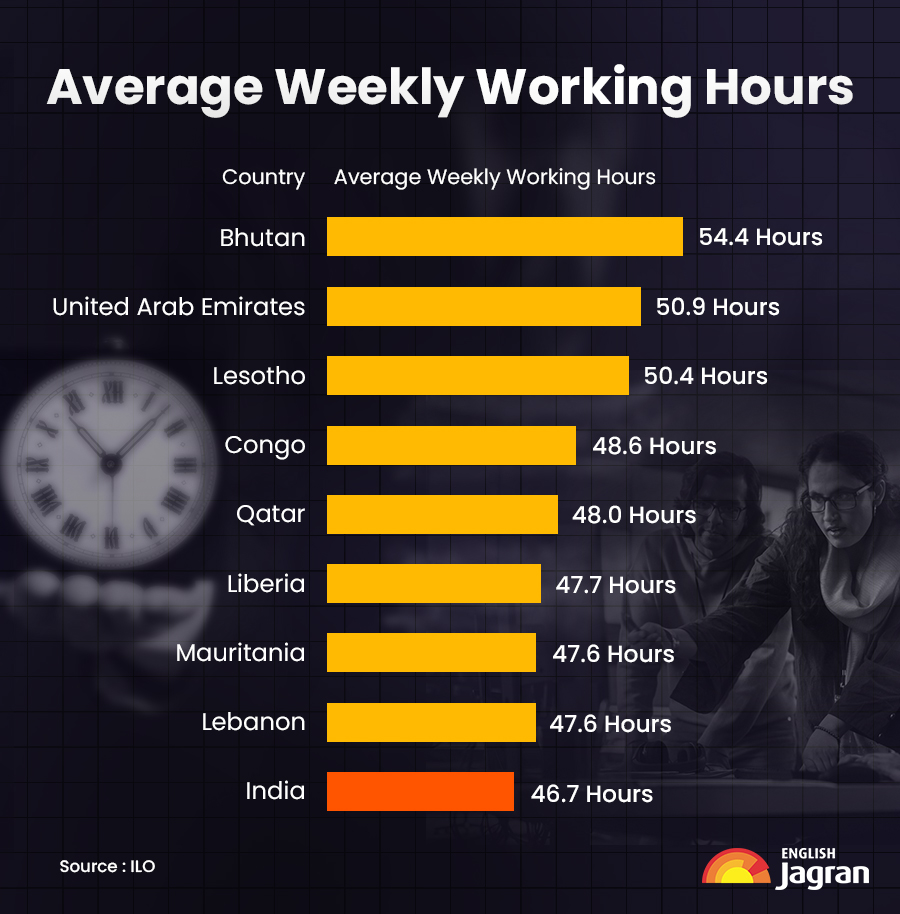
India: The Country with the Heaviest Workload
Data from the International Labour Organization (ILO) reveals that among the world's top ten economies, India has the highest workload. The average weekly working hours per person in the United States is 38 hours, while in China, it stands at 46.1 hours per week. At 32.1 hours, Canada has the lowest average weekly working hours among these ten economies. ILO data further shows that 51 per cent of employees in India work 49 hours or more per week, making it the second-highest in the world.
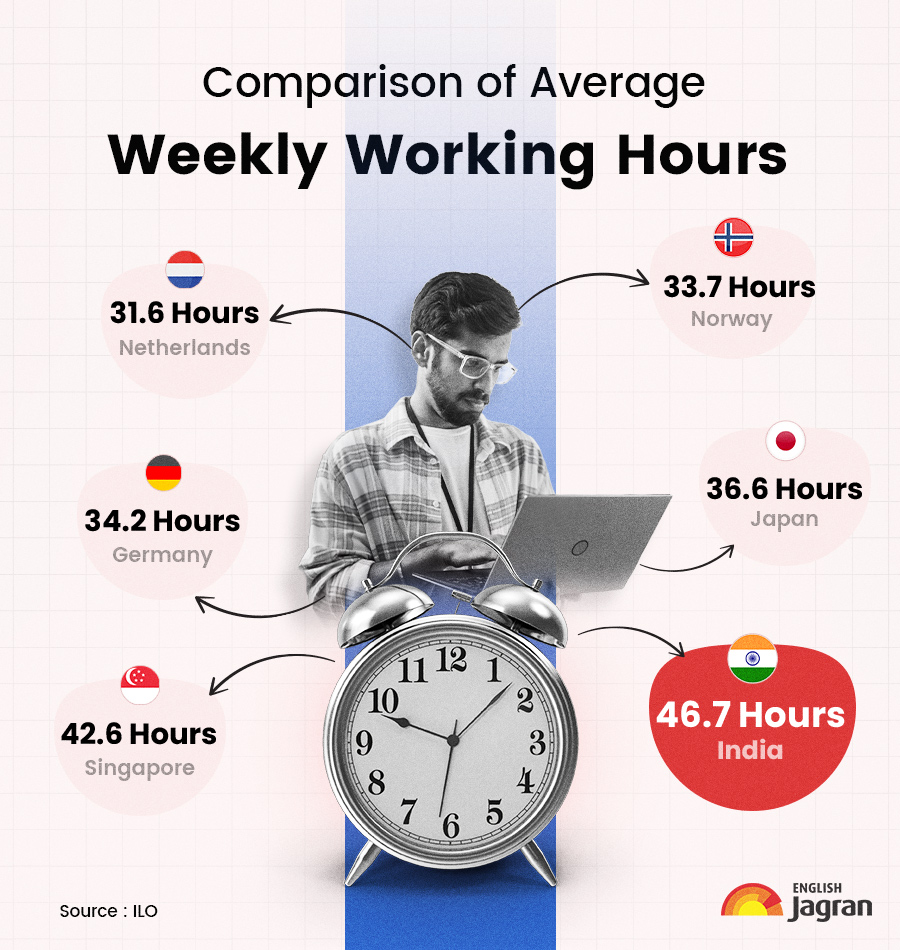
While Bhutan leads globally, with 61% of its workforce working more than 49 hours per week, the inclusion of Bangladesh (47%) and Pakistan (40%) in the top 10 highlights that a significant portion of the workforce in these South Asian countries also works long hours each week.
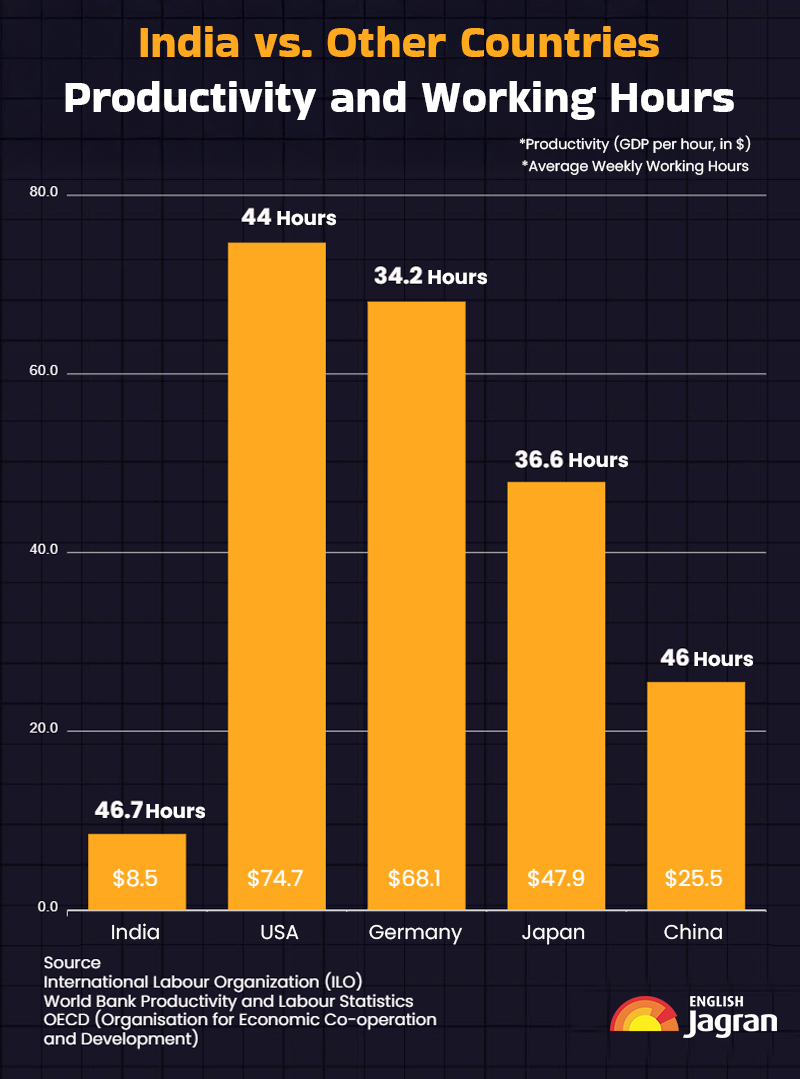
Bhutan (54.4), UAE (50.9), Lesotho (50.4), Congo (48.6), and Qatar (48) are among the countries with the highest working hours, according to the ILO list. On the other hand, Vanuatu has the lowest average working hours per employed person, with just 24.7 hours per week.
Inverse Relationship Between Prosperity and Weekly Working Hours
A study by the International Labour Organization (ILO) suggests an inverse relationship between prosperity and weekly working hours. Countries with fewer working hours generally have a higher per capita Gross Domestic Product (GDP). Among the world's top 10 economies, India has the highest weekly working hours, yet its per capita GDP remains among the lowest.
Average Weekly Working Hours in India
According to the 2023-24 PLFS report, the average number of hours actually worked per week by men and women across all sectors and employment types ranged between 41.7 and 42.7 hours in each quarter of 2023-24. To put this into perspective, this translates to approximately 7 hours per day from Monday to Saturday. This marks a significant decline compared to 2017-18, when the average working hours were between 55.5 and 56.1 hours per week. Work hours tend to be slightly higher during the October-December and January-March quarters compared to the rest of the year. Over the past seven years, the only time weekly working hours fell below 40 was in the April-June quarter of 2019-20.
Additionally, men worked longer hours than women. In 2023-24, men's working hours ranged from 41.5 to 51.4 hours, while for women, it ranged from 30.3 to 44.2 hours. This is a decrease from 2018-19, when men worked 44 to 52.9 hours, and women worked 36.4 to 45 hours per week
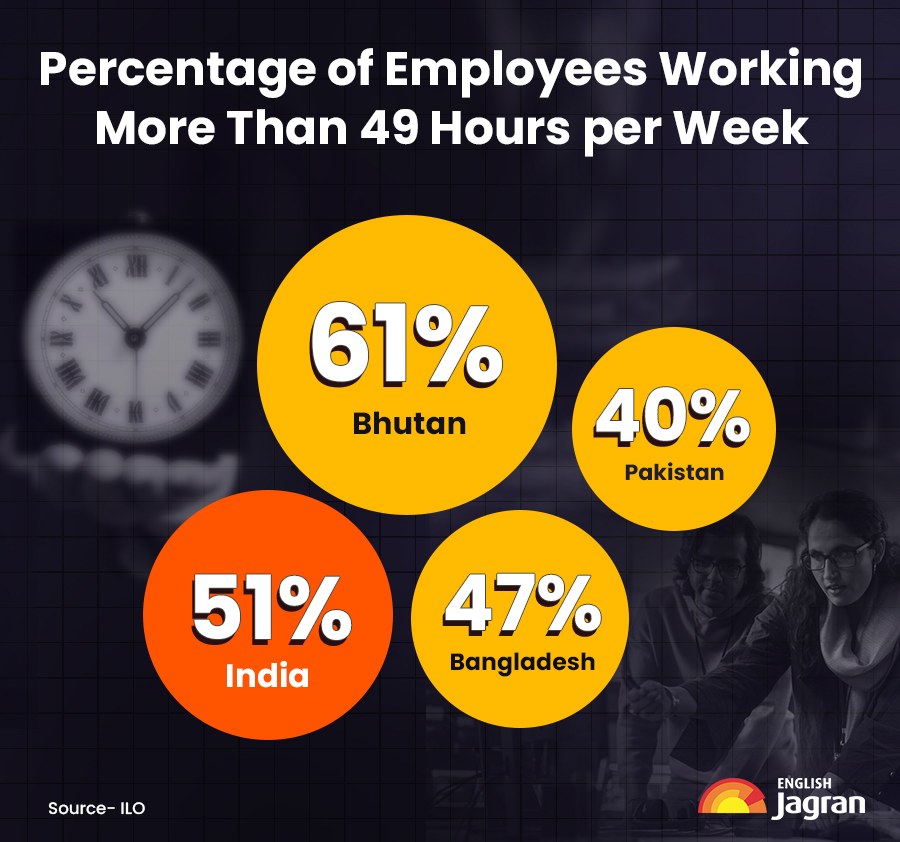
Greater Decline in Working Hours in Urban Areas Compared to Rural Areas
Among rural women, the actual weekly working hours declined from 39.1 to 40.8 hours in 2017-18 to 31.4 - 33.1 hours in 2023-24. For their male counterparts, it dropped from 49.8 to 50.2 hours in 2017-18 to 43.9 to 45.5 hours in 2023-24. On the other hand, in urban areas, the decline was more significant. The weekly working hours for men decreased from 57.4 to 58.1 hours in 2017-18 to 49.4 to 50.4 hours in 2023-24. Meanwhile, for women, it dropped from 47.3 to 47.7 hours to 38.1 to 39.7 hours during the same period. Although the decline in working hours has been more pronounced in urban areas, the actual number of hours worked remains higher compared to rural areas. Additionally, the gender gap in working hours is clearly visible, with men consistently working more hours than women.
Dr. Shamika Ravi, a member of the Prime Minister’s Economic Advisory Council, has published a research paper analyzing how much Indians actually work in detail.
Urban workers work 469 minutes per day (7.8 hours), while workers in rural areas work an average of 399 minutes (6.65 hours).
Government employees work 45 minutes less per day than employees of private or public limited companies. Notably, urban government employees work an hour more per day than their rural counterparts.
Union territories like Daman and Diu and Dadra and Nagar Haveli work more than 600 minutes per day. In contrast, Goa and the northeastern states work less than 360 minutes on average, with Delhi working 8.3 hours and Goa just 5.5 hours.
Employees in the tertiary and secondary sectors work significantly more hours than primary sector employees. Yet Goa’s primary sector bucks this trend with comparatively longer working hours.
Urban women work two hours less per day than men, while rural women lag behind their male counterparts by 1.8 hours.
Working Hours and Economic Growth
Dr. Ravi's analysis highlights the relationship between working hours and economic productivity.1per cent increase in working hours is associated with a 1.7 per cent rise in per capita Net State Domestic Product (NSDP). For larger states, this effect is even stronger for every 1 per cent increase in working hours corresponds to a 3.7 per cent increase in NSDP.

The Reality of a 70-Hour Work Week
Currently, Gujarat has the highest proportion of its population 7.21 per cent working more than 70 hours per week, while in Bihar, this figure is only 1.05 per cent. These statistics, along with significant regional and demographic differences, raise crucial questions about whether the pressure of long work weeks is practical or even fair for everyone.
Better Environment Boosts Employment and Economic Growth
The Economic Survey highlights that fostering an enabling environment is crucial for promoting employment and economic growth. Citing Section 51 of the Factories Act (1948), which states, "No adult worker shall be required or allowed to work in a factory for more than forty-eight hours in any week," the survey points out that this provision limits the number of hours an employee can work per day and per week. However, unlike India, some countries allow these limits to be averaged over several days and weeks, providing greater flexibility in working hours.
Working More Than 12 Hours is Harmful to Health
The Economic Survey states that people who work more than 12 hours a day at a desk often experience difficulties and are more likely to suffer from high stress levels. This warning comes at a time when the debate over working hours is intensifying in the country. Citing a study by the World Health Organization, the survey highlights that depression and anxiety lead to a loss of approximately 12 billion working days worldwide each year, resulting in an economic loss of nearly 1 trillion dollars.
Less Work, Higher Productivity
Countries like Germany and the Netherlands demonstrate high productivity despite shorter working hours. In Germany, employees work an average of approximately 34.2 hours per week, yet the country maintains one of the highest levels of per capita productivity in the world.
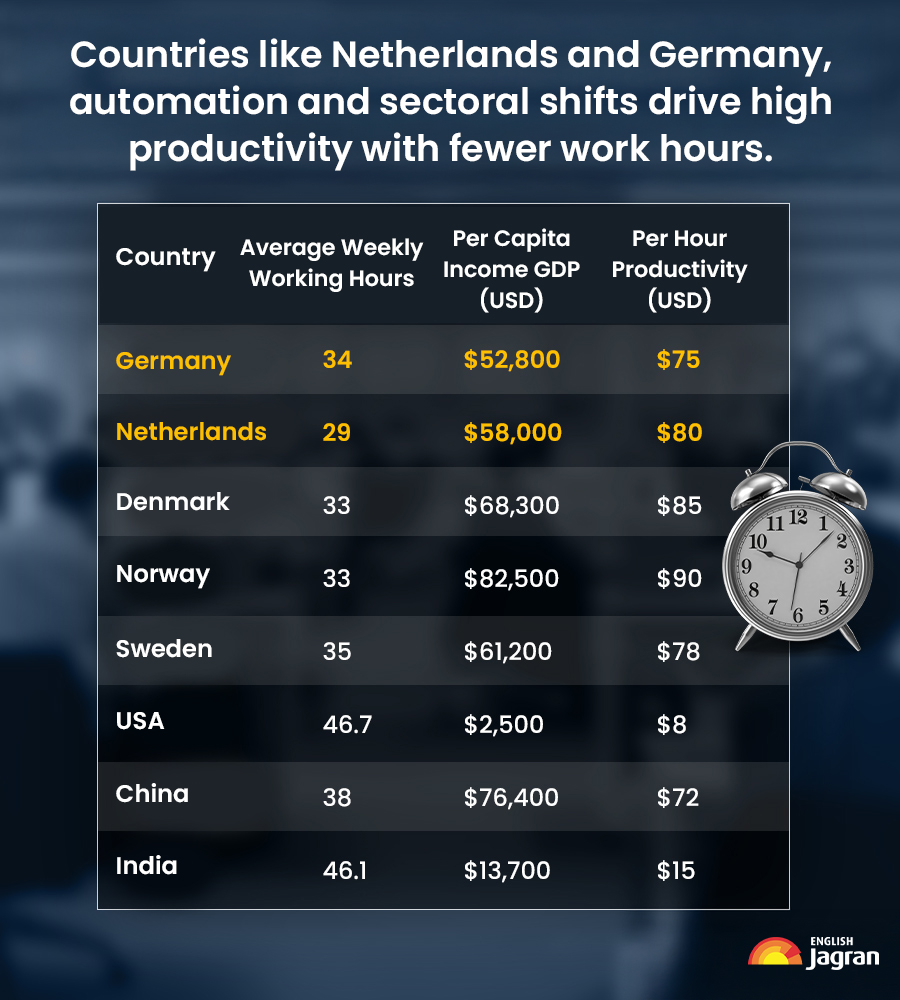
In the Netherlands, the average workweek is just 29.5 hours, the lowest among developed nations yet the country remains economically prosperous. These nations prioritize work-life balance, leading to higher employee satisfaction and efficiency. This clearly indicates that shorter working hours do not hinder productivity but rather contribute to a healthier and more effective workforce.
What the Study Says
Over the past 150 years, the average working hours have dramatically decreased in most countries. People now work fewer hours per day, fewer days per week, and fewer weeks per year,leading to an overall reduction in working time. This trend is especially evident in high-income countries, where work hours have significantly declined, creating differences in working patterns across nations. This study was conducted by economic historians Michael Huberman and Chris Minns.
Impact of the Industrial Revolution
According to the report, working hours declined significantly after the Industrial Revolution in 1870, especially in countries that industrialized earlier. In 1870, most workers labored over 3,000 hours per year, typically 60 to 70 hours per week across 50 weeks annually. However, in today's world, working hours have dropped by nearly half. For example, in Germany, working hours have decreased by 60 per cent, from 3,284 hours per year in 1870 to just 1,354 hours in 2017. Similarly, in Britain, working hours have fallen by 40 per cent. The report also highlights that as working hours declined, paid holidays increased in most countries, improving work-life balance.
How Working Hours Decreased
Data reveals that the reduction in working hours was gradual between 1870 and 1913. However, between 1913 and 1938, working hours declined rapidly due to major social, political, technological and economic changes. These shifts were influenced by World War I, the Great Depression, and the growing tensions leading to World War II. After World War II, working hours dropped significantly. In recent years, many countries have continued to see a decline in working hours, though the pace varies. Countries that industrialized earlier, like Germany, have consistently reduced working hours, whereas in the U.S., working hours have slightly increased in recent years.
Some nations have experienced a U-shaped trend. For example, South Korea saw an increase in working hours between 1950 and 1980, but after 1980, they began to decline. Researchers acknowledge that historical data from 1870 is not available for every country, but studying trends from recent decades has helped them understand long-term patterns.
(This article was translated for Jagran English by Akansha Pandey.)

